A Quick Fix for Inconsistency?
With the return of Anthony Kim to the world of professional golf, choking up on the golf club is front and center. Not coincidentally, a reader recently asked us whether it would be worthwhile to build their clubs over-length so they could choke up on every shot. That sounded like a Golf Myths Unplugged if ever we’d heard one, which brings us to today’s question: Does choking up improve ball striking?
Note: some people prefer “choking down” or “gripping down” to “choking up,” but all these terms describe the same thing: effectively shortening the length of the club by gripping it closer to the club head.
The Myths
Myth #1 – Choking up improves ball striking
Myth #2 – Choking up improves accuracy
Myth #3 – Choking up reduces distance
Myth #4 – Choking up will flight the ball down
Myth #5 – Choking up improves consistency
Myth #6 – Choking up is better than playing a shorter shaft
Myth #7 – Choking up on a longer shaft is better than playing your fitted length
How We Tested
For this test we brought together six golfers with handicaps ranging from scratch to ten. Each player selected their gamer iron shaft in their fitted length as well as +1/2″ and -1/2″, relative to their fitted length. Every player in our test hit four sets of seven shots: one each with the -1/2″ shaft, the standard length, the standard length choked up, and the +1/2″ choked up. The order of testing was different for every player. Each player performed this test with the PXG 0317 CB iron head. [review HERE].
Every shot was measured on Trackman. Testing was done at and with the help of Club Champion.
The Results
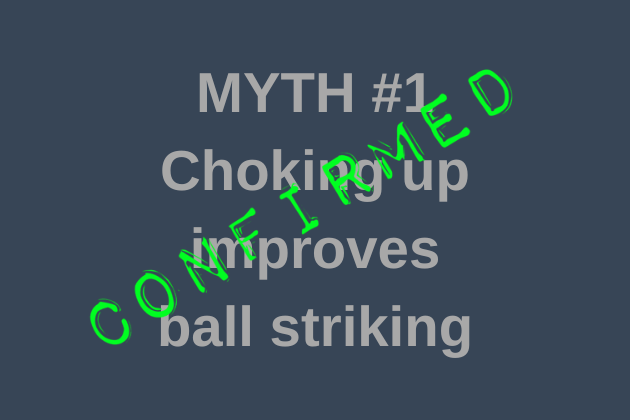
For this myth, we looked at smash factor. Smash factor is ball speed divided by club head speed, essentially a measure of how effectively you transmit energy from the club to the ball. This is the best single metric we have for evaluating the quality of a strike.
For all of our six testers, choking up on their fitted length club improved their smash factor. The differences were substantial with two players seeing jumps of 0.05 and 0.06. For a player with an 85 MPH swing, those improvements would translate to approximately 5 MPH more ball speed! The smallest improvement we saw was 0.03 which is still worth about 3.5 MPH with an 85 MPH swing.
The conventional wisdom holds true: choking up will make it easier to find the center of the club face more often.
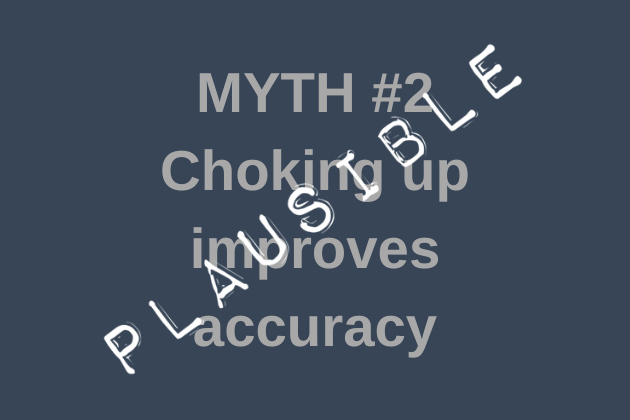
To evaluate accuracy, we looked at two things: the dispersion of a player’s shots from left to right and their distance from the center line. These both need to be taken into account to get a complete picture of accuracy. A player might have a very low average distance to the center line, but their misses could coverage a huge range from left to right. Alternately, a player could have a very tight grouping that’s thirty yards left of the target.
Looking at left to right dispersion, we saw an even split in our test group. Half the group had a tighter grouping with the choked up golf club, half were better when swinging the club at its full length. That said, averaging out the group’s numbers tilted things slightly in favor of choking up. The players who were better with the full length club were better by a small amount. Those that were more accurate with the choked up club were better by a larger amount.
Switching to distance from the centerline, choking up won a more convincing victory. Five of our six testers hit their shots closer to the centerline when choking up, and the margins were substantial. For three of our testers, the standard length choked up set was their most accurate of the four sets.
On balance, it seems plausible that choking up would improve a player’s overall accuracy, though it was not true in every case.
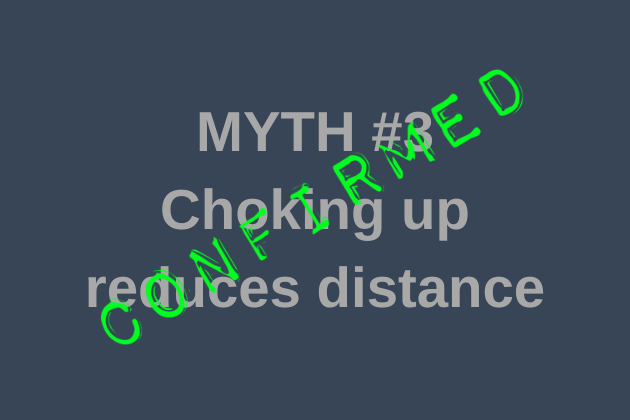
Choking up on a golf club is most often used to “take something off” the shot, but does it actually work? Myth #1 showed us that choking up typically adds ball speed, so this seemed worth investigating further.
We looked at the average carry distance for our six testers and found that choking up did reduce distance, though typically not by much. For two of our testers, the difference was less than one yard. Only one tester saw a difference that was in line with conventional wisdom – seven yards less when choking up.
Two things explain these shorter carry distances in the face of improved smash factor. First, all of our testers saw a slight reduction in club head speed when choking up. Second, the ball flight changed.
Finally, it’s worth noting that we asked our testers to try to make full, equal swings regardless of the club length. It is often the case that players pair choking up with a smaller, less effortful swing. While our testing did confirm this myth, the results might have been more in line with conventional thinking if players were allowed to do what they normally do when choking up.
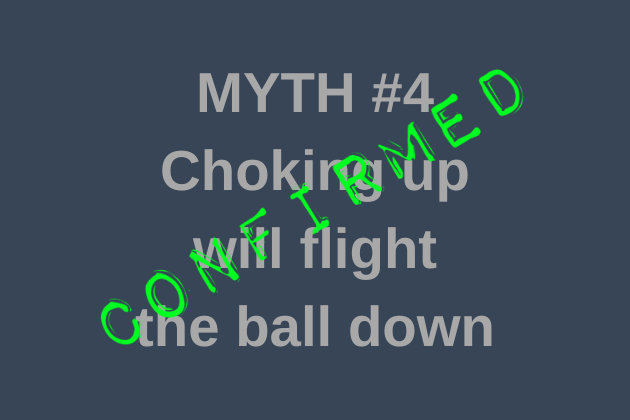
Another reason that players choke up on the club is to lower their ball flight. Our testing confirmed that choking up will flight the ball down.
Each of our testers produced a lower launch angle when choking up. On average, launch angle was reduced by 1.78 degrees. One player dropped their launch angle by 2.7 degrees.
Turning to spin, five of six testers produced less when choking up. On average, our testers created 475 RPM more spin with the club at full length. The one tester who had more spin when choked up only had a gap of 100 RPM. The maximum spin reduction we saw when choking up was 900 RPM.
These differences in launch and spin translated to an average peak height that was 14 feet lower when choking up. The smallest difference in apex was 5 feet and the largest was 23 feet. I would add that, as with our previous myth, this gap might be even larger if players were using an 80% swing.

“Consistency” is a magical word in golf, but it’s rarely well-defined. For this myth, we looked at both the accuracy and the distance dispersion to get an overall picture of how predictable a player’s shots were. Distance dispersion is the gap between a player’s longest and shortest shots.
Since we already found it plausible that choking up improves accuracy, we’ll go straight to distance dispersion. The picture here is similar to what we saw with accuracy: a mix of small losses and big wins for choking up. Half of our testers had less distance dispersion with the full length club, but they were only better by a few yards. The half that was better when choking up saw substantial improvements, sometimes cutting their dispersion in half.
Overall, we can’t go beyond “Plausible” for this myth. While some golfers did see significant improvements in consistency, others did not.
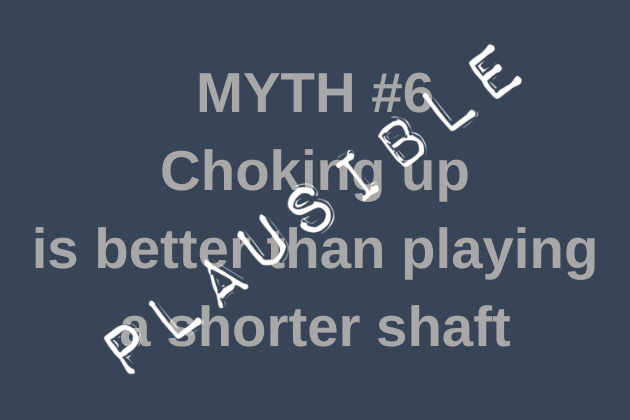
For this myth, we compared the fitted length choked up to the -1/2″ data set. Two things stood out clearly. First, all of our testers achieved better smash factors with the choked up club. The gap was not as wide as when we compared choking up to standard length, but it was consistent across our entire group. Additionally, all players flighted the ball lower – though, again, the difference was not huge – when choking up. This came from universally lower launch angles and spin rates.
The rest of the data was more muddled. Some players were longer with the -1/2″ club, others with the standard length choked up. We saw that same mix when it came to distance dispersion, left-right dispersion, and distance from the centerline.
Overall, this leads us to say that choking up is not better than playing a shorter shaft, though there does seem to be something different about it as evidenced by the lower ball flight and improved smash factor.
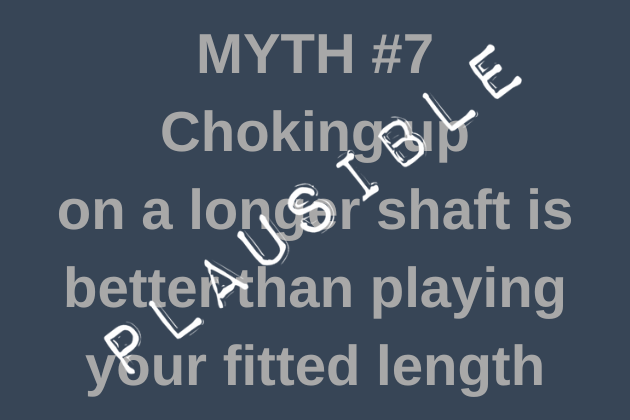
Finally, we compared the data from our players hitting their fitted length shaft to hitting a longer shaft (+1/2″) and choking up. We were surprised to see the same trends continue almost perfectly. All of our testers had lower launch and spin when choking up, and all but one had higher smash factor (one saw no difference).
Turning to distance, only one of our testers hit the longer, choked up club farther. That player gained 2 yards of carry. The other five testers lost an average of 4 yards of carry. As before, this is due to the ball flight being lower than optimal.
Where things got really interesting is when we looked at the accuracy and consistency. Four of our six testers improved their distance dispersion with the longer, choked up club. On average, our group shrank the distance between their best and worst shots by 4 yards. For left-right dispersion, five players were better with the longer, choked up club, and the one who was better at standard length was only better by two yards. Finally, four players placed their shots closer to the center line with the longer, choked up club.
While there is a lot of data here to recommend playing a longer shaft and choking down, it’s not clean enough to call it “Confirmed.” Few players are going to want to give up half a club of distance, and most golfers don’t need to hit the ball lower. That said, the improvements in smash factor and overall dispersion are compelling.
Notes from the Test Panel
This was one of the best test panels we’ve ever had it terms of ball striking quality and how efficiently they got through the testing. However, they were also quite terse, offering little commentary. These two things are probably related – they were more focused on hitting their shots than expounding on the feel differences between plus or minus 1/2″.
That said, I was able to coax a couple of interesting notes from the group. A couple said that when they were choked up they felt like they were “fighting the club.” This was particularly true with the +1/2″ club. It would be interesting to dig into this more and find out how often they hit shots like that on the course. My hypothesis is that these players hit almost all their shots at full length.
Another player said that they felt that the choked up shots were more prone to go left. This was not supported by the data, though it’s impossible to know if that player started adjusting their swing to compensate.
Finally, for those interested: each additional half inch of length added approximately 3 swing weight points.
The Takeaway
While choking up definitely has an impact on ball striking, it’s not clear that everyone should build their clubs over-length and play like Anthony Kim. The improvements in smash factor are compelling, but the lower ball flight and shorter carry distances aren’t going to appeal to most players.
He founded Plugged In Golf in 2013 with the goal of helping all golfers play better and enjoy the game more.
Matt lives in the northwest suburbs of Chicago with his wife and two daughters.
- Performance Golf Click Stick Training Aid Review - October 18, 2024
- Callaway Opus Platinum Wedge Review - October 17, 2024
- When to Take a Break from Golf - October 15, 2024
















27 Comments
Great test, I always feel like I have more control over my ball when chocking the club!
Thanks for doing this test!
Matt:
Absolutely love this article and the data – it confirms what I have experienced with my own swing on course with respect to ball striking / center face hits and distance loss. The satisfaction of centered strikes makes a compelling case for choking up on the club all the time. I never really noticed lower ball flight but haven’t tried this enough to take note while the solid strikes are memorable. I’ve often thought that golf would be easier and I more consistent overall if I played a lower ball flight. Now I have a confirmed method to apply this theory, and I’ll do it using my new Wilson Dynapower irons (non-forged). In addition choking up may also be a way to keep the ball low when hitting shots trouble shots that need to clear tree branches etc.
This will be an interesting and fun test.
Thanks
Mike D.
This series is one of the best a golfer can possibly follow. I’m starting to think they’re in my head since every time a random thought enters my head BAM……a Myth’s article pops up about it the next day……
Thanks, Joe!
-Matt
Great testing by PIG as always. Any comments on the impact that choking up on the following:
– making the shaft play stiffer
– providing a little bit of counterbalancing
– reducing grip diameter due to tapering
And what about choking up but getting lofts weakened a bit?
Jason,
Those are all possible explanations for what we saw, but our testers didn’t express anything about them specifically. If I were hypothesizing, I think the counterbalancing has more impact than the other two things you mentioned, though I think the real driver is the extra grip “above” the player’s hands inhibiting some of the “release.”
To your last question, are you suggesting weakening the lofts to counteract the lower ball flight while still getting the superior smash factor? That’s an interesting idea, and I think a two degree tweak would be more than enough to offset the choking up effect.
Best,
Matt
Great article and great timing! I had just recently noticed someone, I think maybe it was Lydia Ko, who seems to always choke up on the club, and I was wondering if her clubs were .5″ over and she choked down to standard length. Still don’t know the answer to that, but it doesn’t matter. The very subject you covered so thoroughly has been on my mind for the past couple of weeks, but I haven’t had a chance to do any testing myself. I agree 100% with Joe Nixon’s thoughts.
Great info! I recognize many if these findings from my game on the course. Where do you conduct your tests and what are the requirements and parameters needed to be a tester? I think I might be interested in participating sometime, especially if you need a senior golfer! Thanks for your efforts!
Charlie,
We test at Club Champion in Willowbrook, IL. Email [email protected] if you’re interested.
Best,
Matt
This is great stuff. On tv we see the likes of Brooke Henderson and Tommy Fleetwood among those that choke up on every club, and makes one wonder..why not just build shorter clubs? There is definitely a “feels” element to it. I wonder..could there be any element if counter weighting involved? The exposed grip end may not be a ton of weight, but it does offer some weight/balance moved opposite side of the lever. Quick, bring the gang back and go shorter length with counterweight vs choked up. :)
Thanks for this article. Very interesting and shows it is worth all of us experimenting. For me, dispersion is helped choking up but it goes the same distance..I have to narrow my stance more to cut distance off better. What a crazy game. Cheers!
Matt, great article and evaluation as always. Harvey Penick in his Little Red Book has a big dislike for the term “choking up or down” on gripping the club. He felt that was a negative thought. The connotation of choking is very negative. He preferred gripping down or up which has no negativity in placing your hands on the club. I agree with Harvey. It was difficult for me to read the test results with the term choking used. I was using the term gripping down or up as I read to get the negative out of my head from the word “choking”. Other than that it was very informative.
Great article. I’d like to suggest a more positive term rather than “choking”! You never want to set the mental thought of “choking” in a sport.
I like the use of “grip down”.
Very informative. I tried this with my driver last Tuesday with mixed results. I was either choking down too much or was not staying down on the ball. Most shots were off the toe and right. I will do more experimenting because I also hit some pretty good shots.
Can’t do much now because it’s raining here in Iowa.
Ah yes the eternal debate, is it choking down or choking up? Either way, great read!
Choking UP – an americanism for sure. If you’re going UP, surely you are making the club longer, not shorter. Or is this a variation on the constant theme we here from America these days, where people are changing thing UP, rather than just changing things. Badly overdone, much like the infuriating “like” in every sentence these days.
Barry,
If you’re going to come to an American website to complain about the American dialect, you should really proofread your comment, unless Australians use “here” and “hear” interchangeably.
-Matt
Great Golf Myths Unplugged. My first thought is that previously when I have choked down on the shot on the golf course I automatically have a shorter backswing and maybe follow through as it’s usually for a more controlled shot of some kind. Putting a full swing on a choked-down club is not something I’ve done much of but will try it out now.
Neat test!
A couple of questions and thoughts though. Smash was up, spin was down, launch was down, but distance was down too? That seems strange. Was club head speed REALLY knocked down too? If so, why was it so much slower?
In my case, I lose about 3 to 3
5 mph per inch of shortened club. 7-iron is about 92, 9 is about 89 and so on. People were losing more speed than 2 MPH per 1/2″?
I wonder what would happen if you matched swingweights?
George,
The distance question was answered above: too little spin and too little launch to optimize distance.
-Matt
Very cool test. Makes a lot of sense. Thanks.
Great info!
Could gripping lower result in a change of posture and therefore changing the swing path?
Will,
That’s certainly one possibility.
Best,
Matt
Great information! Love your platform, very thorough. Glad to see you call out Barry too. Keep up the good work .
Thanks, Ken.
-Matt
This is one of my favorites I have read on this site, and I really enjoy PIG a lot !
Great job as usual !!
Has given me a lot to think about and how I could best incorporate it into my own game.
I have huge hands, very thick, I wear a size 20 ring and have not found a golf glove that fits my hands without ripping when I sweat.
A fitter 20 years ago gave me clubs 1″ longer and Winn Oversized wrap grips. He said that where my fingers hit the grips is just about the same as a standard length iron. I only have space on the grip to chock down a single wrap down 1″ before I get to the bottom of the grip. I have yardages for normal grip and 1″ down. I have about a 5-7 yard change depending on how hard the greens are. I find, firm greens give less distance change. The ball flights down and loses spin for me. I tend to play the ball about 1/2 a ball back in my stance. I call these my knock down shots. They are very straight and I rarely aim at the pin when hitting a knock down shot, it is normally aimed to a very specific spot in the nearest safe spot on the green.
I have choked down an inch on every club in my bag for the last year and I do not miss many fairways or greens. It’s a no brainer. I do not even see any distance loss either. It is worth trying and I know everyone is different.
66 years old, 6.8 hdcp.